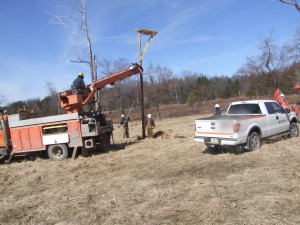
DUBOIS – Students in the Penn State DuBois Wildlife Technology program have joined forces with representatives from United Electric, Lezzer Lumber Company, and the state Department of Conservation and Natural Resources (DCNR) to provide nesting sites for threatened birds of prey. Their work will benefit osprey, a species of bird that lives near water, and feeds predominantly on fish.
The group of five honors students, along with United Electric and DCNR personnel installed two nesting platforms for the birds at Shagger’s Inn, a small lake northeast of Parker Dam State Park in Clearfield County. They constructed platforms that were mounted to the tops of utility poles. United Electric crews installed the poles in the ground using their specialized trucks and equipment designed for work on power lines. Lezzer Lumber donated the building materials for the platforms.
“We tried to create a permanent structure,” said Professor of Wildlife Technology Charles Schaadt, who noted that osprey can live up to 25 years and usually return to the same nesting site each season. “They add to the nest every year and they get bigger, and bigger,” he said.
A pair of osprey had been nesting at Shagger’s Inn in recent years, but recently lost their home when the tree their nest was in fell over. Schaadt and his students hope the structures they built will serve as a replacement to the birds. They also hope another pair will move into the second platform, and have plans to construct more habitat and nesting sites in the future.
“The offspring of those already nesting there will sometimes return to nest, and other birds will find their way there. Eventually a colony will form,” said Schaadt.
Work to reintroduce and sustain the osprey population has been ongoing since the early 1980’s, and those efforts have reduced their status from endangered to threatened in Pennsylvania. The species endured significant loss in numbers due to the widespread use of the pesticide, DDT, beginning in the early 20th century. Studies conducted in the 1950’s revealed that high levels of DDT made it into the fish that they osprey depended on as their primary food source. The contamination caused the birds to lay thinly shelled eggs that could not hold up during incubation of the young, and populations plummeted. DDT was banned in 1972, and since then the osprey population has thrived.
“It’s such a good thing to provide habitat for these birds since they are still threatened in Pennsylvania,” said student Courtney Colley, of Shippensburg. She noted that projects like this provide solutions to practical, real-world problems, while presenting educational opportunities at the same time. She said, “When you learn something, you should actually do it and practice it. This program is very hands-on.”
Fellow student Ben Onusko, of Latrobe echoed that sentiment. He said, “It’s exciting and it’s fun. Building the platforms was good experience, and it helps out a great cause.
Steve Harmic, Penn State DuBois